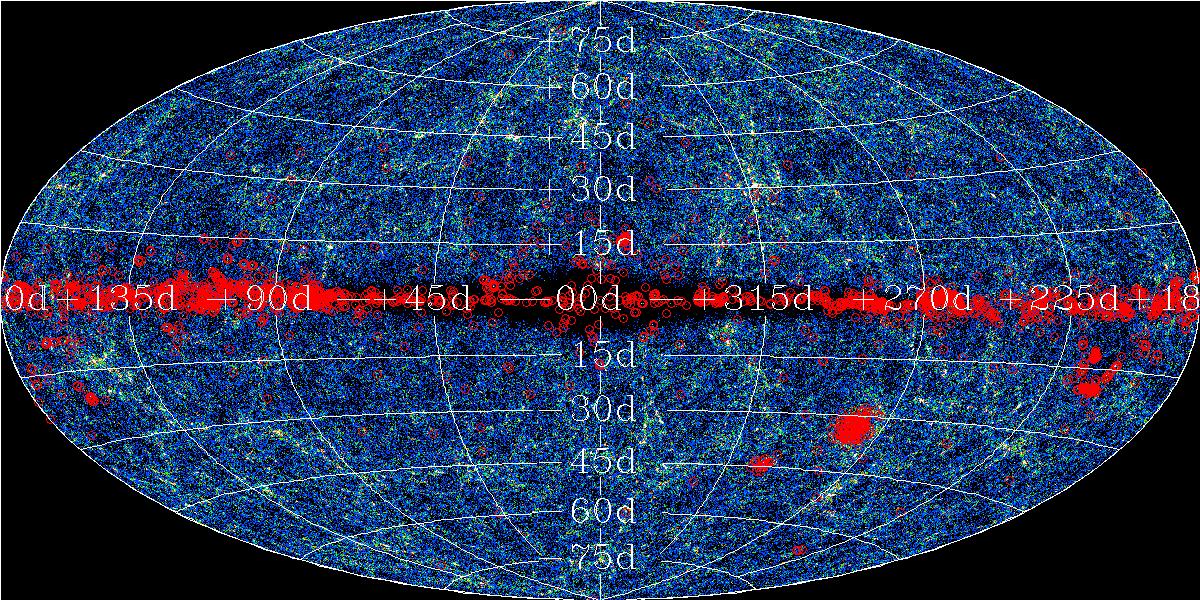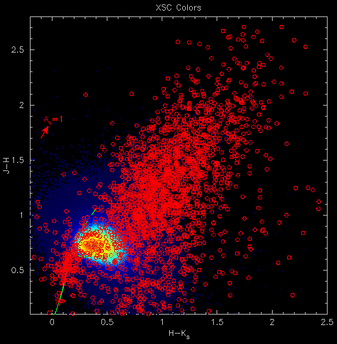
2MASS XSC Galactic Extended Sources
The 2MASS XSC includes sources that belong or are in close proximity to the Milky Way
(e.g., globular clusters, LMC/SMC, ... etc). A wide range of objects and ISM phenomena:
-
planetary nebulae
- young stellar objects and star formation complexes
- HII regions and emission-line nebulae
- reflection nebulae
- globular and open clusters
- stars with extended emission
- Solar System comets
Examples of Galactic fuzzies can be found throughout these documents,
and are compiled in the
XSC Gallery, and the
2MASS Gallery,
and even a few can be found in the
2MASS Large Galaxy Atlas.
Nearly all Milky Way objects
are tightly confined to the Plane of the Galaxy: |glat| < 5 degrees. The exception
to this rule are the giant molecular clouds that float above the Plane
(e.g., Orion, Taurus, Rho Ophiuchus) and the occasional globular hovering in
the spheroid of Milky Way. You can see the extended objects quite easily
in the
XSC Allsky image, lining the Plane in color "red". These objects are both
intrinsically red (e.g., HII regions are dominated by emission bands in the 2 micron
window) and dust-reddened. Since most are confined to the Plane, the Galactic projection
(see below)
of the XSC number counts gives the best view of their spread and distribution.

XSC as seen in a Galactic Projection. The limiting magnitude is 13.5 in Ks, where the
number counts are shown with a false-color scale (to enhance the contrast).
Sources identified as
Milky Way in origin are circled in red. Note the prominent molecular clouds:
Rho Oph, Orion and Taurus, and the clustering of extended sources in the LMC/SMC
galaxies.
To summarize:
- Milky Way objects are mostly confined to the Plane: |glat| < 5 deg
- Milky Way objects tend to be very red (J-Ks > 1.5); see below.
- Milky Way objects are often large in size (radius > 20")
- Milky Way objects sometimes have corrupted mags (due to their oddball shape and confusion)
We have identified some 8,000 sources in the XSC that are probably
Milky Way in origin, with a smaller subset of 3712 sources highly probably
Galactic in nature. The smaller table of Milky Way sources is given
here and are denoted in the above projection and the color plots to
follow.
Colors
The fiducial elliptical isophotal
(20 mag arcsec-2 in the Ks band)
mags are used to construct the colors
J-H, H-Ks, and J-Ks. The XSC sources
(1.65 million total) and the XSC Galactic sources are sub-divided according
to the stellar number
density, which measures the
surface density of stars that the extended object
is projected against.
Density vs. XSC
| density min | density max | %XSC | |Glat| min | |Glat| max |
|---|
| 0.0 | 3.2 | 73.4% | ~25 | 90
|
| 3.2 | 3.6 | 19.0% | ~10 | ~25
|
| 3.6 | 4.0 | 6.9% | ~5 | ~10
|
| 4.0 | 4.5 | 0.7% | 0 | ~5
|
b. J-H vs. H-Ks Color-Color
The following Hess diagrams show the density of points in the color-color
plane, with blue representing sparse, green showing moderate density, yellow
showing high density and red showing the highest density of points.
The Galactic sources are circled in red.
- See also XSC Colors for a discussion of color outliers
Examples of "Red" Milky Way Objects
Nebulosity
YSOs
HII Regions
Source at (0.101620, -12.763147)
Examples of "Blue" Fuzzies:
Comet at (92.836586, 36.640507)
Comet at (213.217377, -15.222510)
See also the
XSC Gallery.
[Last Updated: 2003 Feb 24; by Tom Jarrett]


